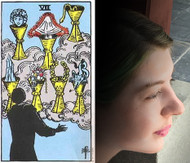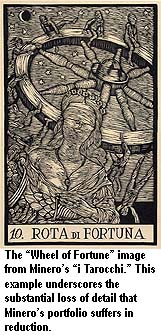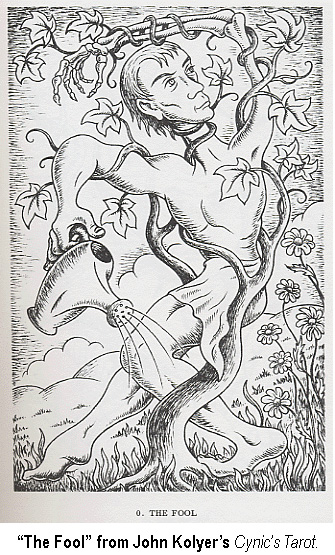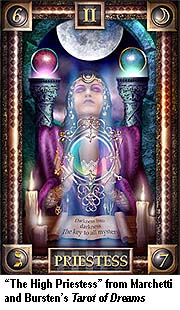The Many Faces of Tarot
Posted by Jeannette Roth on Oct 22nd 2018
Within each acorn lies a mighty oak. And upon each oak grow the acorns that will bear its successors. We all know the metaphor; it is the eternal, relentless cycle of life, each generation carrying within it the seeds for those that will follow.
The history of tarot is a reflection of this cycle, applied to a symbolic form. Archetypal ideas – ancient, powerful, and universal – flowered into the images of the earliest decks. In turn, the expression of these concepts in printed form inspired further study and contemplation, resulting in the creation of modified and evolved decks. In the most highly regarded examples, these decks remain rooted in tarot's original, archetypal seeds, while at the same time attempting to carry forward in the manner of its execution.
As we move from the earliest documented history of tarot to the present day, however, we begin to see a more rapid and varied progression. From the Visconti to the Marseille, through Etteilla and Papus, and on to the Golden Dawn breeding ground that fostered the work of Waite, Crowley, and Case, we recognize the acorns within each oak – the “seeds of inspiration” from which subsequent generations grew. Today, tarot is a thick forest of decks, as artists and visionaries find themselves driven to learn, to explore, and to express these ideas anew – influenced by what has come before, and injecting fresh perspectives and vitality into the cycle that will inspire those who come after.
But just as the oak is shaped by its environment, so too is the form of tarot shaped by the mind in which these archetypal seeds are planted. It is this myriad of unique “mental environments” that not only gives rise to the incredible diversity of decks, but also to a variety of other work that pushes tarot beyond the four-cornered boundaries of the cards. Those whose view of tarot has heretofore been focused upon 78 pieces of cardboard tucked away in a bag, box, or drawer may be surprised to find the many gardens where its images and symbols have begun to bloom…
Art
While painting and illustration remain most common forms of tarot's expression, not all artists strive to explore tarot's divinatory aspects. Removing the emphasis on divination subsequently removes the need to restrict tarot to the medium of the cards. From the two-dimensional world of canvas to the three-dimensional world of sculpture, the essence of tarot is offered up as fine art, with all that the term implies…
Consider, for example, i Tarocchi by Sergio Minero. Cut from linoleum, and issued as a portfolio of prints limited to 250 copies, much of the fine line detail that imbues these 22 major arcana renditions with their vibrancy and drama would certainly have been lost in reduction.
At the other end of the spectrum lies John Kolyer's Cynic's Tarot – 78 cartoonish illustrations published only in book form, filled with social and psychological commentary. Its twisted figures and dark humor reveal the “shadow” side of tarot and, by extension, of ourselves.
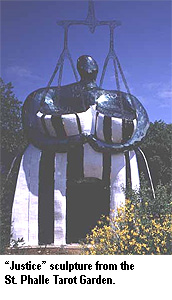
Perhaps the most famous example of a “non traditional” tarot is the magnificent Tarot Garden of French artist and sculptress Niki de St. Phalle. These giant, architectural representations of the major arcana were constructed in a botanical setting over a period of nearly 18 years. The artist herself resided in the “Empress” sculpture for seven years, during a period of particularly intense work on the project. Today, visitors to Capalbio, Italy can visit the garden and experience the “world” of tarot in a nearly literal sense, by taking a stroll among the towering figures, and truly experiencing the tarot both from without and within.
Literature
A picture may be worth 1,000 words, but there's no denying that 1,000 words can be equally potent. Like their fine art counterparts, authors and poets have similarly found inspiration within tarot's images – incorporating its symbols into their writings, or even building entire stories upon its foundations…
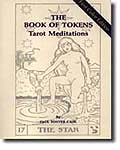
From fleeting but powerful allusions, such as the reading of Madame Sosostris in T.S. Eliot's The Waste Land, to Charles Williams' overt use of tarot as both plot device and metaphor in The Greater Trumps, tarot has clearly left its mark on contemporary literature. Even Paul Foster Case – founder of the Builders of the Adytum and creator of the B.O.T.A. tarot – composed a series of twenty-two tarot “meditations” that, in fact, remain today among the most masterful examples of tarot-inspired poetry. In his classic Book of Tokens, tarot's images and its constellations of symbols become powerful verses that are both captivating and instructional. Consider this excerpt from “The Meditation on Vav” (The Hierophant):
I am the revealer of all mysteries
None other is the Teacher of any man.
These words that thou readest,
Whose words are they but mine?
I have brought thee before me to instruction
And whether thou receivest it willingly or unwillingly,
Know that because thou hast this day heard or read these words,
Thou art henceforth consciously united to me.
Here, once again, we see the “cycle” in action, as Case's words inspire further thought and reflection, becoming the “seed” of the reader's inner or overt creative processes.
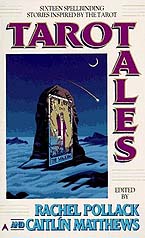
A growing number of authors, both aspiring and professional, have begun to look to tarot as a tool for writing. In her introduction to the anthology Tarot Tales, Rachel Pollack writes:
“In 1987 I attended the second Merlin Conference, in London. For my contribution I decided to tell a story, using the Solleone Tarot. I mixed the cards two or three times until one picture, a woman running with a stick, seemed to click something into place and I had the beginning of a tale of a woman who curses herself and her family. If the beginning came quickly, the end remained stubborn, causing me some nervous moments until an hour before my scheduled appearance, when the cards finally yielded up a suitable ending.”
Some online communities that serve both students of tarot and students of literature and writing have begun to further explore the use of tarot as a tool for this sort of storytelling. These “greenhouses” of tarot-inspired prose may become the springboard for a new generation of fiction in which the line between surface story and metaphor become deliciously blurred.
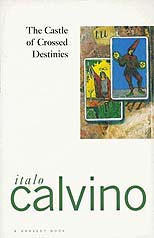
Perhaps one of the most famous examples of tarot-inspired writing is Italo Calvino's The Castle of Crossed Destinies, where the cards themselves truly tell the story. The narrator, taking respite in a castle whose residents are unable to speak or utter any sound, watches as his fellow travelers pull cards from a deck in order to communicate their tales:
“One of the guests drew the scattered cards to himself, leaving a large part of the table clear; but he did not gather them into a pack nor did he shuffle them; he took one card and placed it in front of himself. We all noticed the resemblance between his face and the face on the card, and we thought we understood that, with the card, he wanted to say ‘I’ and that he was preparing to tell his story.”
Calvino's novel thus becomes a sort of contemporary Decameron – but one that begs the question as to whether the “listener” is “hearing” the story being told, or whether his interpretation of the cards reveals more about himself than about the storyteller.
Music
Music encompasses a symbolic vocabulary different from that used on page or canvas, but its impact is no less powerful. Its ability to capture abstractions of thought make it an ideal medium for conveying the tremendous impact of tarot's emotional and intuitive characteristics…
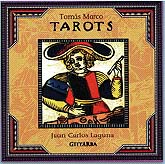
Perhaps the most obvious approach to musically interpreting the tarot is to create melodic “vignettes” for various cards. The major arcana appears to hold the most interest for composers, from Juan Carlos Laguna's contemporary guitar interpretations of the Marseille images in Tomás Marco -- Tarots, to synthesizer compositions exploring The Fool through The Wheel in Kevin Kendle's Tarot (from New World Music's “Mind, Body, and Soul” series). But a few scattered musical portraits of minor arcana can be found as well – most notably Emerald Joy and Paul Tye's Cups of the Heart, which offers individual songs and musical poems for all fourteen cards of the Cups suit.
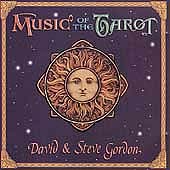
Other composers have taken a broader view, finding inspiration in larger structures rather than individual elements. In Music of the Tarot by David and Steve Gordon, the listener travels through the major arcana in three segments – one devoted to cards 0 through 6, the next to cards 7 through 14, and finally to cards 15 to 21. The Gordons then proceed to delve into the minors by dedicating one holistic composition to each suit.
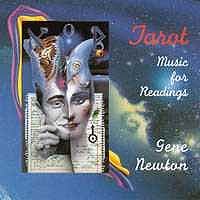
In yet another fascinating example of tarot's “chain of inspiration,” we see song collections inspired not by cards or groups of cards, but actually by specific decks. The Rohrig Tarot provides the catalyst for Gene Newton's Tarot: Music for Readings, which features not only musical descriptions of tarot's structure, but works that explore and celebrate the whole of the reading process. And in Osho Zen Tarot, the listener is treated to thirteen original free-form works by various artists, whose inspiration is rooted in the beauty and mystical “flavor” of the deck of the same name, rather than in any specific cards or structure.
Film and Television
Formerly a mere staple of second-rate mystery and horror flicks, today's filmmakers have recently begun to tap into the truly powerful metaphors that tarot offers. Now ingrained into our collective psyche, tarot's familiar icons provide a “grounding point” for intriguing tales, imbuing stories with both mood and meaning…
 In François Gerard's acclaimed film, The Red Violin, tarot becomes the unifying thread for a series of events in the history of a famed musical instrument. Like the allegorical “Fool's Journey,” we see the paths and connections that shape our lives, and the lives of those we touch.
In François Gerard's acclaimed film, The Red Violin, tarot becomes the unifying thread for a series of events in the history of a famed musical instrument. Like the allegorical “Fool's Journey,” we see the paths and connections that shape our lives, and the lives of those we touch.
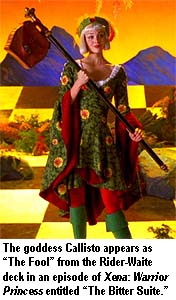
Perhaps the most talked-about television event within the tarot community was an episode of Xena: Warrior Princess entitled “The Bitter Suite.” Framed almost entirely in tarot symbolism and set to music, the show weaves a compelling parable of forgiveness and redemption. The use of some of tarot's most recognizable images (particularly those from the Rider-Waite deck) was so appropriately selected and applied that the episode received universal praise for its faithfulness to both the established history of the show's storyline and to the meanings of the cards themselves.
Other media
Inspiration and creativity are expressed in many forms, beyond those commonly viewed as the “traditional fine arts.” When in the grip of tarot's powerful muse, each seeker finds a way to express their connection to it through the medium of their own individual visions and talents…
After the phenomenal success of his first deck, The Gilded Tarot, digital artist Ciro Marchetti joined with Gay Tarot creator Lee Bursten to re-envision the traditional format of the “cards” in the new Tarot of Dreams. While including a printed version of their work in traditional deck form, Marchetti and Bursten's original self-published edition also included a CD-ROM containing animated versions of the cards. By using the CD, students and readers were presented with a fluid, ever-changing view of the images, providing new perspective and depth for readings and meditation.
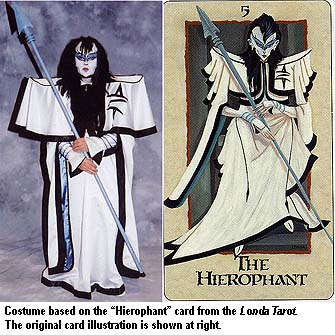
One interesting approach to understanding the cards is to “become” them. Visualizing oneself inside various cards has long been a part of the practice of tarot meditations. But in 2002, one group of novice and journeyman costumers from Des Moines, Iowa literally “stepped into the shoes” of the major arcana, bringing the cards to life. Inspired by designs from the Londa Tarot, and later by the Buckland Romani Tarot, a competition-level series of costumes were constructed, which were then presented at the 2002 Archeon masquerade in St. Louis, Missouri. The costumes and presentation were awarded “Best in Show”. Further information on this project will be available in a future blog post.
Conclusion
It is interesting to speculate on what the original creators of tarot – whoever they may have been – would think about how these 78 powerful cards are presented today. Perhaps they intended to inspire our spiritual journeys, but could they have foreseen how tarot would fuel our creative energies as well? With each re-envisioning and re-execution of tarot's images and symbols, we delve deeper into its mysteries and emerge with a new and greater understanding of its lessons. We are at once gardens and gardeners – allowing tarot to grow within us, and finding our own method of tilling the soil for those who follow…
Where will your acorns fall?

